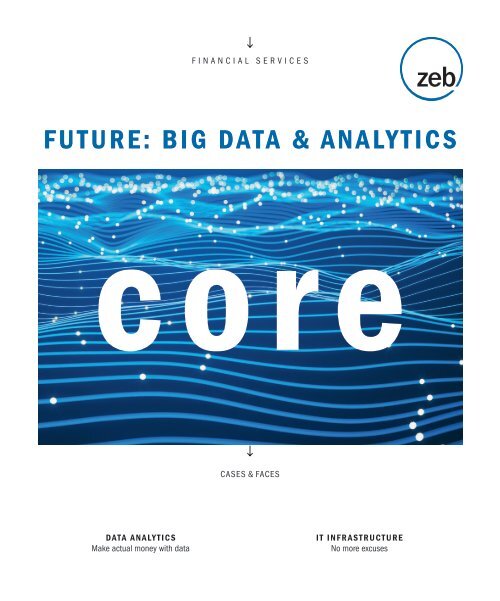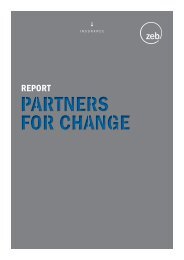core_#5_Big Data_Analytics_DIGITAL
You also want an ePaper? Increase the reach of your titles
YUMPU automatically turns print PDFs into web optimized ePapers that Google loves.
FINANCIAL SERVICES<br />
FUTURE: BIG DATA & ANALYTICS<br />
CASES & FACES<br />
DATA ANALYTICS<br />
Make actual money with data<br />
IT INFRASTRUCTURE<br />
No more excuses
It’s not a hype,<br />
but the future of banking<br />
DATA ANALYTICS HAS BECOME PART OF DAILY LIFE<br />
Customers appreciate digital convenience. The success of all the “Googles” and “Amazons”<br />
has proven it: customers are willing to pay for it with their data.<br />
TECHNICAL SOLUTIONS ARE EASILY ACCESSIBLE<br />
Cloud services provide almost unlimited storage capacity and offer analytics modules as<br />
well as compute capacity. This is one of the reasons why IT is no longer the limiting factor.<br />
BIG DATA NEEDS STRATEGY AND GOALS<br />
Comprehensive knowledge, reasonable usage scenarios and effective approaches matter:<br />
data analytics does not make things automatically better, just different.<br />
FORM FOLLOWS FUNCTION<br />
Define the strategy first, then identify requirements and finally select the appropriate tools.<br />
The analytics strategy is a closed loop.<br />
THINK BIG, START SMALL<br />
The starting point is a structured approach including a status quo analysis, a target image<br />
and individual use cases. Thus, the long-term vision (“think big”) is broken down to exploratory<br />
prototypes (“start small”).
Welcome<br />
to <strong>core</strong><br />
During the Cold War, American banks and authorities were good<br />
customers of Mosler Safe Company. The Ohio-based enterprise<br />
built gigantic steel doors for vaults—said to be ”ready to<br />
withstand nuclear bombing” as several Mosler safes at Mitsui<br />
Bank had resisted the attack on Hiroshima.<br />
In recent years, financial services providers have been faced with<br />
the dilemma of not only fulfilling high security standards but also<br />
meeting the customers’ wishes for transparency, convenience,<br />
openness and service. After all, people have swapped their hard<br />
currency for cards and online banking in cashless payment<br />
transactions.<br />
wishes who entrust a financial services provider with their entire<br />
financial and personal time line. They do not only demand<br />
security, but a holistic service in particular. The image of a<br />
locked safe as the synonym for banks is fading. Networking is<br />
the new paradigm.<br />
We hope you will enjoy the read.<br />
When payment instruments and investments are transformed<br />
into data, we need financial services providers who aggregate<br />
useful services for all aspects of customer data and use them<br />
intelligently, individually and at the right time.<br />
Professional processing of different data is the key to generating<br />
new values, since it is the basis for innovative technologies such<br />
as distributed ledger, mobile payments, augmented reality,<br />
financial platforms and artificial intelligence.<br />
<strong>Big</strong> data & analytics is not a necessary evil for banks, but gains<br />
a footing for their economic future. The “21st century oil” needs<br />
to be discovered, extracted and refined—the value chain will be<br />
reforged.<br />
In this Core issue, you will find answers to the most important<br />
questions on big data & analytics as well as the latest case<br />
study of an established financial services provider in this area.<br />
Between the lines, the constant appeal resonates to take<br />
customer needs very seriously.<br />
Carsten Werner, Senior Manager<br />
carsten.werner@zeb-consulting.com<br />
Sebastian Brecht, Senior Manager<br />
sbrecht@zeb.de<br />
FUTURE: BIG DATA & ANALYTICS<br />
Mosler Safe Company also had to learn a lesson: Bank safes are<br />
no longer a unique selling point—today, the focus is on people’s<br />
3
The future of banking<br />
<strong>Big</strong> data & analytics is a real challenge—and also the way into the<br />
future of banks. The focus is on customer loyalty, sales optimization,<br />
process efficiency and risk control. With the right solution approach<br />
and a proven method, successes can be achieved step by step without<br />
losing sight of the strategic goals.<br />
FUTURE: BIG DATA & ANALYTICS<br />
4<br />
fter ten years, the impact of the financial and<br />
economic crisis can still be perceived: regulatory<br />
requirements, balance sheet and stress tests, a<br />
heterogeneous global economic situation and the low<br />
yields of central banks put institutions under pressure. New<br />
competitors, changed requirements in retail banking and short<br />
technological innovation cycles add up to the situation. The<br />
industry has been in defensive mode for years.<br />
“What is the object of defense? To preserve. To preserve is easier<br />
than to acquire,” the Prussian general Carl von Clausewitz once<br />
wrote. A credo that no longer applies to today’s banks. The wind<br />
of change is blowing so strong that banks require a strategic<br />
redesign rather than preservation.<br />
One reason is the requirement for European banks to increase<br />
the capital base and to sustainably improve profitability. zeb<br />
analyses have shown in this context that efficiency measures<br />
alone are not sufficient to meet regulatory requirements under<br />
current market conditions—let alone the shareholders’ wishes.<br />
Another reason is the bank’s requirement to redesign the interface<br />
to the customer: They demand “digital proximity”—virtually<br />
intimacy—with relevant services anywhere and anytime.<br />
The use of big data & analytics combines both requirements<br />
and leverages desired potentials. The functional scope ranges<br />
from customer interface and process optimization to improved<br />
risk management. Algorithms model the new appearance of the<br />
bank to process customer requirements in real time, to make<br />
services understandable and to monetize offers in terms of<br />
sustainable profitability.<br />
The digital world seems like the land of milk and honey: Map<br />
services navigate us through Castile and also save the address<br />
and price category of the hotel almost in passing. Facebook reminds<br />
us of important events, birthdays and offers of our favorite
Aside from traditional master data and transaction history, modern customer data<br />
also includes location history, Facebook likes or wish lists for online shopping.<br />
Integrating numerous platforms allows for bundling this data and for accessing and<br />
processing high volumes of data with a great level of heterogeneity (variety) almost<br />
in real time (velocity). Here is an example: 400 hours of video footage are uploaded<br />
to YouTube every minute and more than half of the videos are accessed via smartphone.<br />
brands. Amazon makes book recommendations based on our<br />
reading behaviors and those of 100,000 other customers—for<br />
free, anywhere, anytime, without asking.<br />
Perfectly knowing the customers and understanding their<br />
individual needs is the key to income potential—not only for<br />
banks. With every year that passes unused, web companies<br />
set new standards at the interface to the customer and financial<br />
services providers are increasingly under pressure to take<br />
action.<br />
<strong>Big</strong> data & analytics as a field of work related to collecting,<br />
preparing, analyzing and interpreting (customer) data will be the<br />
<strong>core</strong> driver for the transformation of banks. Only a comprehensive<br />
understanding of the customer and their wishes enables direct<br />
approaches using personalized offers. Individual marketing,<br />
which is about tailored offers with a high level of efficiency, is the<br />
future of banking.<br />
Potentials are tapped, for example, by cross- or up-selling, optimizing<br />
pricing and regaining migrated customers. Including<br />
data from social media and other online data in the determination<br />
of creditworthiness is also possible and reasonable.<br />
In addition, big data & analytics can be used to collect and<br />
process feedback to optimize products and services. All bank<br />
customers will benefit from these lessons learned—and from<br />
these insights the financial services providers can directly<br />
derive the demand for their offers to specifically allocate<br />
resources.<br />
The development in big data & analytics is a great opportunity<br />
for banks: customers nowadays expect simple, transparent and<br />
secure digital services that add value. In return, they voluntarily<br />
disclose personal information—the seed for the new digital harvest.<br />
Financial services providers only need to plant, water and<br />
use fertilizer as necessary. This applies to the culture, processes<br />
and IT.<br />
FUTURE: BIG DATA & ANALYTICS<br />
5
TRANSFORMATION MILESTONES<br />
As part of digital transformation, banks face five <strong>core</strong> challenges:<br />
They need to foster the dialog and<br />
interaction with customers and set<br />
incentives so that required information<br />
will be provided.<br />
It is not necessarily the amount of<br />
data that defines the value—it is<br />
about the right questions.<br />
Focusing on actual needs and<br />
priorities of customers is essential<br />
for banks.<br />
FUTURE: BIG DATA & ANALYTICS<br />
6<br />
THINK BIG, START SMALL<br />
As opposed to the high tech pioneers, banks and insurance<br />
companies already have usable information on a large scale and<br />
there is no need to explicitly compile, collect or purchase them.<br />
Besides, IT is no longer a limiting factor despite other common<br />
beliefs. The constantly growing cloud services alone open<br />
up new ways that can also increasingly be taken by financial<br />
services providers. Many institutions have identified the topic,<br />
react and want to face competition. Awareness among top<br />
management has released budgets—ideal conditions to become<br />
a success story.<br />
The challenges of digital transformation often caused first initiatives<br />
to fail or they did not bring about the desired effects.<br />
Implementing isolated technological innovations for their own<br />
sake has never proven to be a success formula. Even a fully digitalized<br />
process not embedded in the environment (goals, infrastructure,<br />
culture) does not create value but effort and frustration<br />
instead. A high level of uncertainty among banks and customers<br />
regarding legal topics such as GDPR adds up to the situation.<br />
Considering the numerous options, many banks cannot see<br />
the forest for the trees and are therefore not able to realize the<br />
desired potential benefits—provided that they had been clearly<br />
defined in the first place. Although it is true that digitalization is<br />
a comprehensive and powerful toolkit, the following still applies:<br />
“Form follows function”. First requirements have to be developed<br />
and then the right tools have to be selected next. Otherwise a<br />
lane is cut through the wrong forest.<br />
A sensible approach therefore requires analyzing the status quo<br />
of the digital maturity level and identifying relevant use cases and<br />
their dependencies for the institution. For example, this could<br />
be achieved by applying integrative approaches such as design<br />
thinking: It can be used to determine which customer data is<br />
actually needed—or which is not—as well as the resulting need for<br />
adaptation of systems, processes and customer interaction.<br />
It is necessary to develop a structured approach including status<br />
quo analysis, target image and specific use cases tailored to the<br />
individual business and strategy. The decisive question is: What
For customers, the information<br />
gathered has to be transformed<br />
into convenient services and thus<br />
stands for flexibility, freedom or<br />
reduced complexity.<br />
Technical support for collecting,<br />
preparing, processing and using<br />
data needs to be ensured.<br />
is the strategic directive? Is it about sales, risk control or process<br />
efficiency? The long-term vision (“think big”) needs to be broken<br />
down to manageable small modules (“start small”) in order to<br />
be able to test them and to control their benefit.<br />
need.” Without the help of big data & analytics, there is no<br />
holistic answer to this question today.<br />
The target image reflects the strategy and includes the service<br />
portfolio’s cornerstones, processes and the basis of the organization,<br />
governance, technical architecture and IT infrastructure.<br />
Only in a next step does the actual implementation and application<br />
begin with prototyping and the rollout of use cases while<br />
customer feedback has to be used for optimization.<br />
The advantages of this approach are both the transparency<br />
and the early achievement of initial results. An early involvement<br />
of customers and joint testing also ensures resource efficiency<br />
in development and implementation. This engenders trust<br />
within the organization for digital transformation, because here<br />
as well it is key that the guiding principle is established in the<br />
employees’ minds: “To be able to think from the customers’<br />
perspective, you really need to understand what they want and<br />
Your contacts<br />
Carsten Werner, Senior Manager<br />
carsten.werner@zeb-consulting.com<br />
Sebastian Brecht, Senior Manager<br />
sbrecht@zeb.de<br />
FUTURE: BIG DATA & ANALYTICS<br />
7
Check-up of data analytics:<br />
“Make actual money with your data”<br />
<strong>Data</strong> analytics is a key instrument to compete in customer loyalty and market shares.<br />
Sparkassen-Finanzgruppe recognized this trend early on and offered banks a powerful<br />
data analytics platform through FI and S-Rating. For example, more than 30 use cases<br />
were provided in 2018. Conversion rates increased while efforts were reduced as a<br />
result. Still, many potentials remained untapped. zeb experts Christian Schäfer and<br />
Carsten Werner know why banks should integrate data analytics into their entire value<br />
chain and how to do this efficiently.<br />
What is the current implementation status in banks?<br />
CHRISTIAN SCHÄFER: One has to admit: The initial euphoria has vanished due to high expectations<br />
and implementation challenges. About 70 percent of savings banks have meanwhile subscribed to<br />
the use cases, but only few have integrated data analytics into the value chain correctly. Better<br />
models fizzle out if data analytics is not holistically implemented. The desired sales automation can<br />
be realized only in part—solutions for the “next best action” are being developed at the moment.<br />
However, it is essential to make the key success factors and the individual maturity level transparent<br />
early on.<br />
FUTURE: BIG DATA & ANALYTICS<br />
8<br />
What is decisive for successfully using data analytics?<br />
CARSTEN WERNER: Fundamentally, the focus is on orienting the entire value chain towards new<br />
opportunities. Starting with the integration into the business strategy, the task also includes the<br />
definition of the ambition level to be able to measure if data analytics actually achieved the desired<br />
success in the end. In addition, organizational questions need to be clarified regarding employee<br />
skills and, in this case, the suitability of processes in sales management: Do I use CRM and campaign<br />
management in a suitable way? Are my controlling activities aligned accordingly and is my<br />
sales staff able to bring the horsepower to the road? Finally, you need to define the data quality as<br />
the basis and the legal framework.<br />
What does that mean for a savings bank in concrete terms? How would you describe the zeb approach?<br />
CHRISTIAN SCHÄFER: We analyze the entire value chain with a readiness check and determine the<br />
maturity level for each topic field using best practices. Depending on these findings, we derive and<br />
prioritize specific measures together with the client. We definitely benefit from new perspectives that<br />
we can contribute from our data analytics projects and from our long-standing project experience for<br />
the entire field of success factors. The combination of these aspects enables us to provide an objec-
LEARN<br />
ANCHORING IN BUSINESS STRATEGY<br />
INTEGRATION OF BDA INTO<br />
SALES MANAGEMENT<br />
LEGAL REQUIREMENTS<br />
AND ADVERTISEMENT CONSENT<br />
RATIO<br />
EVALUATION OF USE CASES<br />
AND DEFINITION OF THE<br />
LEVEL OF AMBITION<br />
STRINGENT<br />
DATA QUALITY MANAGEMENT AND<br />
USE OF CRM<br />
ESTABLISH SKILLS AND<br />
EMPOWER SALES<br />
DEVELOP<br />
Assessment of the maturity level along the success factors<br />
tive, market-oriented assessment and specific solutions. Through implementing prioritized fields of action<br />
at an early stage, the necessary acceptance and professionalism for data analytics is generated<br />
from the very beginning.<br />
CARSTEN WERNER: Of course, there are many options—the different topic areas should, however,<br />
always be deliberately considered and defined. The desired potentials can only be leveraged if all<br />
pieces of the puzzle fit together. Here as well, the following applies: “Think big—start small.” Banks<br />
should have a vision, but should start with selected use cases. Thus they can specifically learn to<br />
align the organization, convert employees’ reservations into acceptance and then broaden their experience<br />
in the area of data analytics step by step.<br />
FUTURE: BIG DATA & ANALYTICS<br />
Your contacts<br />
Carsten Werner, Senior Manager<br />
carsten.werner@zeb-consulting.com<br />
Christian Schäfer, Manager<br />
christian.schaefer@zeb.de<br />
9
CORE CASE<br />
Getting to the point faster<br />
Hackathons are a proven means to experience practical use cases<br />
within a short time for all stakeholders.<br />
t these programming events that usually take 24 to<br />
48 hours (hack and marathon), different teams try to<br />
find the best solution for a problem, e.g. for<br />
forecasting the amount of damage based on contract<br />
data in the area of car insurances.<br />
Can you turn ideas into complex innovations in just one weekend?<br />
zeb hosted a hackathon for a German insurance company<br />
to evaluate the business potential of new technologies. The<br />
focus was on data analytics—data was available for the use<br />
case, the level of complexity was manageable and the business<br />
relevance was high.<br />
33 percent for liability insurances and 21 percent for fully<br />
comprehensive insurances.<br />
As the ambitions did not remain a mere declaration of intent,<br />
but were turned into tangible results in the end, both the<br />
participants and the members of the boards were captivated by<br />
the success of the hackathon. The event also served as a proof<br />
of concept that members of specialist departments are able to<br />
beat established claim models using data analytics tools in a<br />
short time. In addition, the event clearly underlined the economic<br />
potential of data analytics for portfolio data.<br />
FUTURE: BIG DATA & ANALYTICS<br />
10<br />
As part of the zeb hackathon, three interdisciplinary teams<br />
with six members each competed against each other on the<br />
premises of the insurance company. The <strong>core</strong> task was to find<br />
appropriate data sources and to develop and parameterize<br />
algorithms. The three teams were each supported and coached<br />
by a zeb expert who was experienced in data analytics models<br />
and the data basis.<br />
After 48 hours, all teams had found ways to compare historical<br />
claims with the forecast of the algorithms on single<br />
contract level. Thus, the existing models could be significantly<br />
optimized: Damage forecasts could be enhanced by at least<br />
20 percent for liability insurances and by eight percent for<br />
fully comprehensive insurances. A reference model developed<br />
by zeb in advance was able to achieve an improvement of<br />
Your contacts<br />
Jörg Bischoff, Senior Manager<br />
jbischoff@zeb.de<br />
Tomas Sebastian Hätälä, Manager<br />
shaetaelae@zeb.de
“Banks can no longer hide<br />
behind IT complexity”<br />
IT organization and culture: business informatics specialist Prof. Dr. Nils Urbach<br />
from the University of Bayreuth about the changes banks need to<br />
implement for all aspects of the digital customer interface.<br />
Prof. Urbach, what are the key IT tasks that banks need to solve as part of<br />
digital transformation?<br />
NILS URBACH: The biggest challenges to me are not technological issues, but rather the organization<br />
and culture. Strongly regulated banks are required to reconcile their traditional world and shining<br />
innovations. At the same time, business and IT need to work much more closely together and resolve<br />
borders in the line. This takes time and requires a different culture with new ways of thinking: one has<br />
to learn that the previously unpopular IT is what makes a difference nowadays—and not traditional<br />
banking.<br />
What is the problem of the cooperation between business and IT?<br />
NILS URBACH: IT is a crucial differentiator, but you need to actually bring the technological horsepower<br />
on the road and develop promising innovations. Many institutions are only aware of the threat and<br />
meanwhile fail to look for new opportunities, to analyze, to implement and to integrate them into their<br />
service portfolio.<br />
<strong>Data</strong> analytics in particular is where hopes are pinned in digital transformation.<br />
What is the potential behind it?<br />
NILS URBACH: With data analytics, current business models can be optimized, as there surely still is<br />
substantial room for improvements. But each bank needs to think about ways to reasonably expand<br />
the existing business model based on available data and new technologies. The goal is to defend<br />
or even win back the interface to the customer. Today, this can only work out if you understand the<br />
customer and service them individually to increase their level of convenience. After all, digital markets<br />
are characterized by the small number of players with a large market share: “The winner takes it all.”<br />
The rest acts as an infrastructure provider.<br />
One reason for the rather moderate speed of transformation is the high level of<br />
technical challenges caused by IT legacy issues and the lack of skills.<br />
NILS URBACH: Banks can no longer hide behind IT complexity. In the past, only large banks could<br />
afford the latest technologies and skills while nowadays I can start AWS and a Hadoop cluster within<br />
hours. This also empowers small and medium-sized banks and IT is thus no longer the limiting factor.<br />
We have advanced technologically and can do much more than we currently use. In the area of mobile<br />
payment new competitors are already getting ready. Therefore, digitalization initiatives in the labs<br />
finally need to be consistently launched on the market.<br />
FUTURE: BIG DATA & ANALYTICS<br />
11
It’s not a hype,<br />
but the future of<br />
banking.<br />
LINK TO E-PAPER<br />
WWW.ZEB.EU/CORE/BIG_DATA<br />
Publisher zeb.rolfes.schierenbeck.associates gmbh, Hammer Str. 165, 48153 Münster, Germany, www.zeb.eu<br />
Contacts Carsten Werner, e-mail: carsten.werner@zeb-consulting.com, Sebastian Brecht, e-mail: sbrecht@zeb.de,<br />
Editor Andrea Rothländer-Busch, Marketing & Communications, e-mail: publications@zeb.de<br />
This publication has been prepared for general guidance only and does not take into account the reader‘s individual investment objectives or risk tolerance. The reader should not act<br />
according to any information provided in this publication without receiving specific professional advice. zeb rsa GmbH shall not be liable for any damages resulting from any use of the<br />
information in the publication. No part of this document may be reproduced, copied, distributed or transmitted in any form or by any means without written permission from zeb.<br />
© zeb rsa GmbH 2019. ALL RIGHTS RESERVED.













